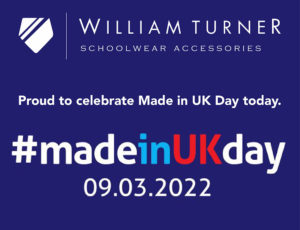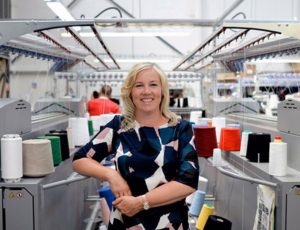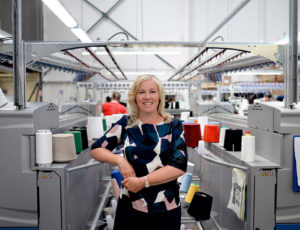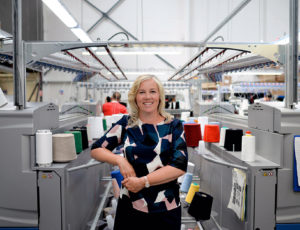
Kate Hills, founder and CEO of Make it British, discusses the nuts and bolts of manufacturing in the UK and why the demand for local industry is growing.
Laura Turner: What is Make it British’s mission?
Kate Hills: The focus has evolved over the years, but the main one currently is to help and support British brand founders who want to start and grow product-based businesses that are made in the UK. Another part of our mission is to highlight all the wonderful UK manufacturing that still takes place in Britain.
LT: What factors are contributing to the growth in UK textile manufacturing?
KH: More people want to make locally; more people understand the benefits of making locally; and more people than ever are starting their own businesses and want to use a local factory or are opening micro-factories to make the products themselves, particularly since lockdown. The other main reason is that since Brexit there are rising costs of making overseas, increased costs of shipping and unreliability of supply chains, with items being held up at borders.
LT: Is the infrastructure there for continued growth?
KH: When I first set up Make it British 11 years ago I was amazed by the fact that the manufacturers within the industry didn’t all know each other. The whole supply chain had become fragmented, but it’s starting to come together now. We’re seeing a lot of new, small manufacturing facilities opening up, particularly to help meet the demand of smaller businesses. We also saw the first UK cotton spinning plants open a few years ago after not having spun cotton here in decades.
There are still some areas that cause bottlenecks. Dye houses, for example, are very expensive to set up. There aren’t enough in the UK to meet the demand. There are still a lot of trims that aren’t made in the UK too, although we’ve got a couple of button manufacturers − Courtney & Co. opened a few years ago to make natural buttons and is doing amazingly well.
LT: What are the main benefits of manufacturing a fashion brand in the UK?
KH: You’ll have a much lower carbon footprint if you’re making locally, which is why many people are now interested. Face-to-face visits with your manufacturer and conversations in the same language as those who are making your products also enable better communication, so ironing out any kinks in your supply chain is much easier and the whole process is more transparent.
In addition, the provenance of having that Made in the UK label on a fashion brand adds great value when it comes to overseas customers. I’m also seeing more specific and hyper-local labelling, such as Made in London, Made in England or Made in Wales.
LT: What typically prevents a fashion brand from making in the UK?
KH: Sometimes there is a perception that making in the UK is more expensive. Fashion brands will compare the cost price for making in the UK versus somewhere overseas, but you’re not just comparing eggs to eggs. Making in the UK offers so much more flexibility, your lead times are shorter, and it can be much more profitable because you don’t have to buy huge amounts of stock.
Another hurdle can be raw materials or certain types of manufacturers not being available here. Some products are more difficult to make in the UK too. Anything that’s extremely detailed or highly labour-intensive isn’t viable, for instance. Finally, it is so important to develop a partnership with your UK manufacturer. Make the most of having that communication and the opportunity to visit in person. If you prefer doing everything by email, then you might as well make somewhere overseas.
LT: What pitfalls could a brand encounter without the right guidance?
KH: For a start, trying to find manufacturers on Google and ending up with someone that might give the impression they’re a UK manufacturer because they have a UK-based office, but they’re not actually going to make your production in the UK, they’re going to make it overseas. When it comes to fashion specifically, a common pitfall is not understanding the difference between how overseas and UK manufacturers work in terms of full service versus CMT basis.
Most UK manufacturers work on a CMT basis − cut, make and trim. You need to supply all the raw materials and trims and the manufacturer will do the assembly part. The majority of overseas manufacturers offer a full service. I am seeing a few more UK manufacturers offering a full service, but of course, they price accordingly. Having that control over sourcing your own materials is much better anyway; at least you will know the costs and have total control.
LT: Anything else to consider?
KH: Yes, another trap is not giving manufacturers enough guidance. You need to run your own quality control; make sure you’re involved every step of the way during the production process. Cutting corners on the product development side − not getting a final production sample or failing to sign everything off properly – can result in the production not being what you expected.
Another common mistake is buying too much stock. Rather than finding a manufacturer that can make a small minimum order, the brand goes to one that insists they buy a larger quantity than they need or can sell. All your money is then tied up in stock and you can’t sell it quick enough. Finally, there’s the issue of developing a product for yourself but not knowing who your end customer is or how you’re going to market and sell your products. Some of the best brands launched recently are those that have already built up an audience. When they go to market, they know who they’re selling to, or tap into someone else’s existing audience by working with influencers and brand ambassadors.
LT: What is your British Brand Accelerator programme and who is it for?
KH: It’s a group coaching programme. We work with British brand founders – start-ups and existing businesses that want to re-shore their production − to launch and grow their product-based companies. We can help them with the whole product development process; everything from finding manufacturers to setting up a marketing plan and selling the products. Because it’s a group programme, businesses also learn from each other. We have people developing everything from babywear, kidswear and womenswear to dog products and homeware. No matter what type of product it is, they all have the same issues and challenges.
LT: What other resources does Make It British provide?
KH: We offer a lot of free information and downloadable guides for businesses that want to launch a brand in the UK or understand more about working with UK manufacturers. For those launching fashion brands, we have tech pack templates, cost price calculators and other similar resources.
There’s also the Make it British podcast, which now has over 240 episodes, and a YouTube show at 1pm every Tuesday. Both offer tips and advice for making in the UK and interviews with inspiring brands that already do make in the UK. We used to run a trade show too, Make it British Live, but that sadly closed due to Covid.
LT: What else does your website offer?
KH: It includes a directory of Make it British members that are manufacturers, including clothing manufacturers and fabric and trim suppliers. Members also get to advertise on our website, which attracts over 100,000 visitors every month, many of whom are looking to buy UK-made products. One thing we’ve found with small businesses that make in the UK is that they’re great at developing products, but they’re not so good at marketing themselves, so we provide guest expert master classes every week on relevant topics for small businesses like marketing, social media logistics and PR. You can find all this information and more by visiting our website.
A Make it British Virtual Forum will take place on Thursday 3 November. The schedule includes actionable workshops, panel discussions, and expert training on growing a British-made brand. For further information and to book tickets, please click here.











